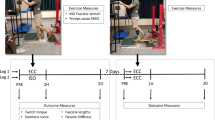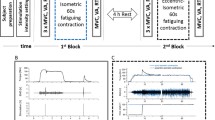Abstract
The stretch-shortening cycle (SSC) is an effective and natural form of muscle function but, when repeated with sufficient intensity or duration, it may lead to muscle damage and functional defects. A reduced tolerance to impact has been reported, which may be partly attributed to a reduced stretch-reflex potentiation. The aim of the present study was to examine the influence of SSC-induced metabolic fatigue and muscle damage on the efficacy of stretch reflexes, as judged by the electromyograph (EMG) response of two shank muscles (lateral gastrocnemius LG, soleus SOL) to controlled ramp stretches. These EMG responses were recorded before and immediately after exhausting SSC-type leg exercise and 2 h, 2 days and 4 days later. Serum concentrations of creatine kinase ([CK]), myoglobin and lactate were measured repetitively along the protocol. Two maximal vertical drop jumps and counter-movement jumps were performed after each reflex test. The exhausting SSC-type exercise induced an immediate reduction (P < 0.05) with a delayed short-term recovery of the LG peak-to-peak reflex amplitude. This was not accompanied by significant changes in the reflex latency. The drop jump performance remained slightly but significantly reduced (P < 0.05) until the 2nd day postexercise. Peak [CK] appeared for all the subjects on the 2nd day, suggesting the presence of muscle damage. The increase in [CK] between the 2nd h and the 2nd day postexercise was found to be negatively related (P < 0.001) to the relative changes in the drop jump height. Furthermore, a significant relationship (P < 0.05) was found between recovery of the stretch reflex in LG and the decrease of [CK] between the 2nd and the 4th day. hese findings support the hypothesis of a reduced stretch-reflex sensitivity. While the exact mechanisms of the reflex inhibition remain unclear, it is emphasized that the delayed recovery of the reflex sensitivity could have resulted from the progressive inflammation that develops in cases of muscle damage.
Similar content being viewed by others
References
Aura O, Komi PV (1986) Mechanical efficiency of pure positive and pure negative work with special reference to the work intensity. Int J Sports Med 7:44–49
Balnave CD, Thompson MW (1993) Effect of training on eccentricinduced muscle damage. J Appl Physiol 75:1545–1551
Dietz V, Schmidtbleicher D, Noth J (1979) Neuronal mechanisms of human locomotion. J Neurophysiol 12:1212–1223
Duchateau J, Hainaut K (1993) Behaviour of short and long latency reflexes in fatigued human muscles. J Physiol 471:787–799
Fields HL (1987) Pain. McGraw-Hill, New York, p 35
Fridén J, Sjöström M, Ekblom B (1983) Myofibrillar damage following intense eccentric exercise in man. Int J Sports Med 4:170–176
Fukami Y (1988) The effects of NH3 and CO2 on the sensory ending of mammalian muscle spindles: intracellular pH as a possible mechanism. Brain Res 463:140–143
Garland SJ (1991) Role of small diameter afferents in reflex inhibition during human muscle fatigue. J Physiol 435:547–558
Gollhofer A, Schmidtbleicher D (1989) Stretch reflex responses of the human m. triceps surae following mechanical stimulation. In: Gregor RJ, Zernicke RF, Whiting WC (eds) Congress Proceedings of the XII International Congress of Biomechanics. Los Angeles, USA (Abstr) Univ of Calif, Los Angeles, pp 219–220
Gollhofer A, Komi PV, Miyashita M, Aura O (1987a) Fatigue during stretch-shortening cycle exercises: changes in mechanical performance of human skeletal muscle. Int J Sports Med 8: 71–78
Gollhofer A, Komi PV, Fujitsuka N, Miyashita M (1987b) Fatigue during stretch-shortening cycle exercises: II. Changes in neuromuscular activation patterns of human skeletal muscle. Int J Sports Med 8 [Suppl I]:38–47
Hikida RS, Staron RS, Hagerman FC, Sherman WM, Costill DL (1983) Muscle fibre necrosis associated with human marathon runners. J Neurol Sci 59:185–203
Hortobagyi T, Lambert NL, Kroll WP (1991) Voluntary and reflex responses to fatigue with stretch-shortening cycle exercise. Can J Sports Science 6:142–150
Huijing PA (1991) Elastic potential of muscle. In: Komi PV (ed) Strength and power in Sport. Oxford, Blackwell Scientific Publications, pp 151–168
Häkkinen K, Komi PV (1983) Electromyographic and mechanical characteristics of human skeletal muscle during fatigue under voluntary and reflex conditions. Electroencephalogr Clin Neurophysiol 55:436–444
Kirsch RF, Rymer WZ (1992) Neural compensation for fatigueinduced changes in muscle stiffness during perturbations of elbow angle in human. J Neurophysiol 68:449–470
Kuiffki KD, Mense S, Schmidt RF (1978) Responses of group IV afferent units from skeletal muscle to stretch, contraction and chemical stimulation. Exp Brain Res 31:511–522
Koceja DM, Kamen G (1988) Conditionned patellar tendon reflexes in sprint- and endurance-trained athletes. Med Sci Sports Exerc 20:172–177
Komi PV, Bosco C (1I978) Utilisation of stored elastic energy in leg extensor muscles by men and women. Med Sci Sports 10: 261–265
Macefield G, Hagbarth KE, Gorman R, Gandevia SC, Burke D (1991) Decline in spindle support to x-motoneurones during sustained voluntary contractions. J Physiol 440:497–512
Mense S, Meyer H (1988) Bradykinin-induced modulation of the response behaviour of different types of feline group III and IV muscle receptors. J Physiol 398:49–63
Moritani T, Oddson L, Thorstensson A (1990) Electromyographic evidence of selective fatigue during the eccentric phase of stretchshortening cycles in man. Eur J Appl Physiol 60:425–429
Moritani T, Oddson L, Thorstensson A (1991) Activation patterns of the soleus and gastrocnemius muscles during different motor tasks. J Electromyogr Kinesiol 1:81–88
Nardone A, Romano C, Schieppati M (1989) Selective recruitment of high-threshold human motor units during voluntary isotonic lengthening of active muscles. J Physiol 409:451–471
Newham DJ, Jones DA, Clarkson PM (1987) Repeated high-force eccentric exercise: effects on muscle pain and damage. J Appl Physiol 63:1381–1386
Nicol C, Komi PV, Marconnet P (1991) Fatigue effects of marathon running on neuromuscular performance. I. Changes in muscle force and stiffness characteristics. Scand J Med Sci Sports 1:10–17
Nicol C, Komi PV, Horita T, Kyröläinen H, Takala TES (I993) SSC fatigue effects on stretch-reflex sensitivity. In: Bouisset S, Métral S, Monod H (eds) The XIVth I.S.B Congress, Paris, France, (abstract from book of the Congress) Paris. pp 940–941
Noakes TD (1987) Effect of exercise on serum enzyme activities in humans. Sports Med 4:245–267
Rotto DM, Kaufman MP (1988) Effect of metabolic products of muscular contraction on discharge of group III and IV afferents. J Appl Physiol 64:2306–2313
Sherman WM, Armstrong LE, Murray TM, Hagerman FC, Costill DL, Staron RC, Ivy JL (1984) Effect of a 42.2-km footrace and subsequent rest or exercise on muscular strength and work capacity. J Appl Physiol 57:1668–1673
Stuart DG, Callister RJ (1993) Afferent and spinal reflex aspects of muscle fatigue: issues and speculations. In: Sargeant AJ, Kernell D (eds) Neuromuscular fatigue. North Holland, Amsterdam, pp 169–180
Synoway LI, Hill JM, Pickar JG, Kaufman MP (1993) Effects of contraction and lactic acid on the discharge of group III muscle afferents in cats. J Neurophysiol 69:1053–1059
Vuori J, Rasi S, Takala T, Väänänen K (1991) Dual-label time resolved fluoroimmunoassay for simultaneous detection of myoglobin and carbonic anhydrase III in serum. Clin Chem 37:2087–2092
Warren GL, Lowe DA, Hayes DA, Karwoski CJ, Prior BM, Armstrong RB (1993) Excitation failure in eccentric contraction-induced injury of mouse soleus muscle. J Physiol 468:487–499
Winter DA, Fuglevand AJ, Archer SE (1994) Cross-talk in surface electromyography: theoritical and practical estimates. J Electromyogr Kinesiol 4:15–26
Author information
Authors and Affiliations
Rights and permissions
About this article
Cite this article
Komi, P.V., Horita, T., Kyröläinen, H. et al. Reduced stretch-reflex sensitivity after exhausting stretch-shortening cycle exercise. Eur J Appl Physiol 72, 401–409 (1996). https://doi.org/10.1007/BF00242268
Accepted:
Issue Date:
DOI: https://doi.org/10.1007/BF00242268




